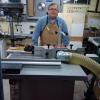
Originally Posted by
Matt Mattingley

Jack, even though I believe in some of your theories. I do believe some of your theories could be wrong. I call this the chicken or egg.
For example, the etching on the table was it done to quadrant specifications... or was the quadrant machined to the table etching? Surely there is tolerance take up and realignment in any machine. After carefully analyzing all my numbers, my motor was out of alignment mine motor is out 0.003 to the natural state of the fence. I would consider this not that bad as my reference area is 14 inches( and machine 70+ years old). I did take all fence grub screws for alignment out. Fence grub screws are used for micro adjustment.




 Reply With Quote
Reply With Quote



